Basque Country: typically thought of as the northern sliver of Spain, most people think of San Sebastián. But there’s the French Basque Country (Pays Basque, as it’s known in French) too, with three departments marrying some of the best of France and Spain together in a tiny area occupying the southwest corner of the Nouvelle Aquitaine region. While many tout San Sebastián as the foodie capital of the world, there’s something to be said for the delicious cuisine of French Basque Country. And yes, it is very different than that of the Basque Country just over the Spanish border. If ever there were a place that should have an organized food tour, it’s Saint-Jean-de-Luz.
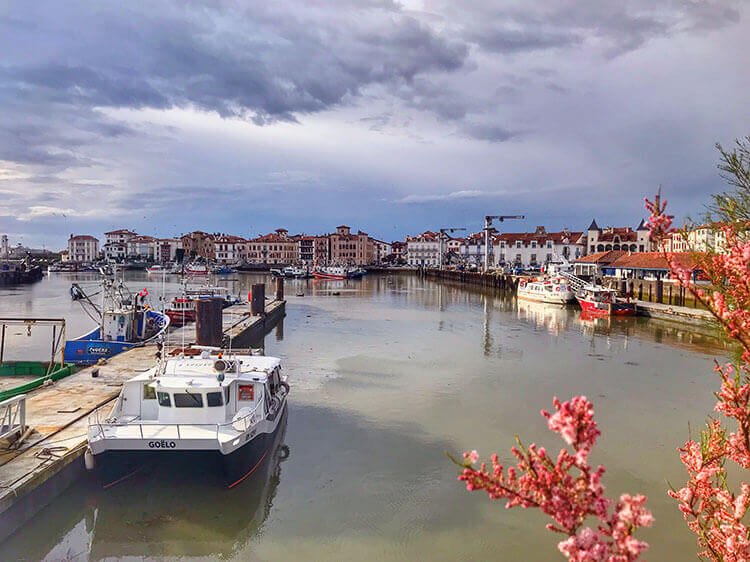
Saint-Jean-de-Luz is famous first as the tiny fishing town where one of the most important political marriages in history took place. On June 9, 1660 Louis XIV married Maria Theresa of Spain in the cathedral of Saint-Jean-de-Luz, ending a long and bitter war between France and Spain. That marriage also brought about the creation of various French Basque specialties, some of which were created for the wedding and are still closely guarded recipes to this day.
There’s no guided food tour to lead you around Saint-Jean-de-Luz and help you discover the best products and their stories {not yet, anyway}, but we ate our way through this colorful French Basque town in the name of research. You may have come for the beaches, but don’t miss trying these French Basque specialties while you’re visiting:
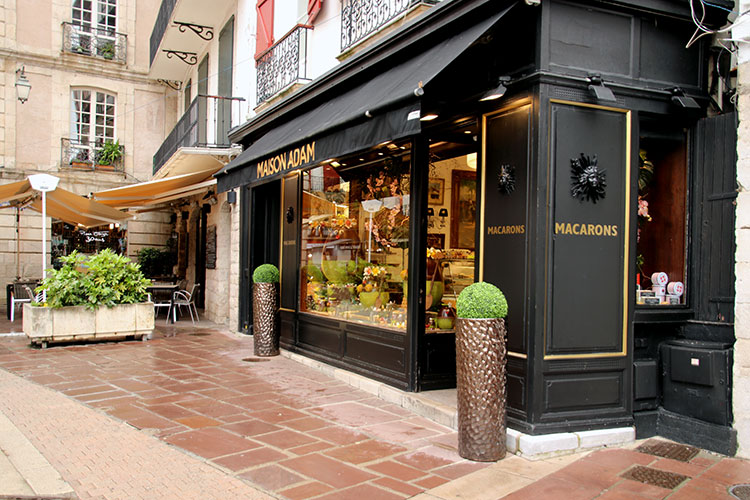
The Basque Macaron: Maison Adam
The world over knows the French macaron: that wonderfully delicious almond flour cookie sandwich filled with jam or ganache. But the history of the French macaron far proceeds the double-decker macarons made famous by Ladurée. In fact, the Basque macaron predates Ladurée by about three centuries.
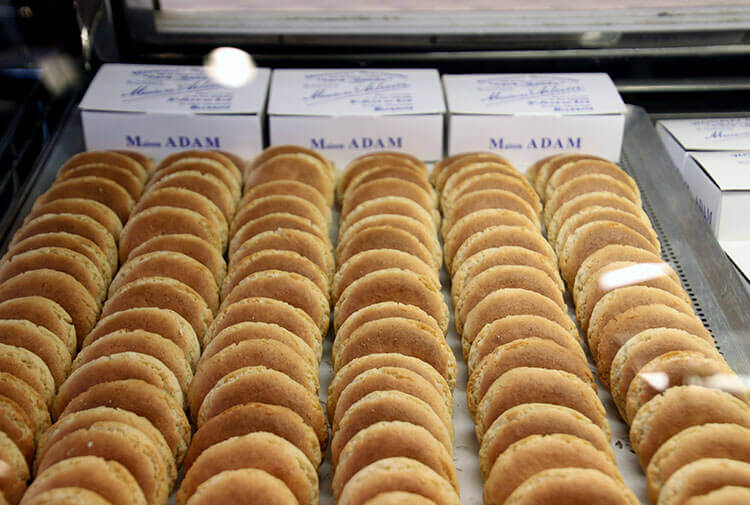
Maison Adam was founded in 1660 by a pastry chef named Adam. Adam’s most VIP of clients were Louis XIV and Maria Theresa themselves. Like many of the shop-keepers, Adam sent his best product over to the royal mansion for the Queen Mother, Louis XIV and his fiancé to sample ahead of the wedding preparations. All three were delighted so much by the Basque macarons that they were ordered to be served at the royal wedding.
Resembling nothing like the glistening pastel creations of Ladurée, these macarons are more rustic. Made of almond flour, sugar and egg whites, the recipe has been handed down through the family for over three centuries and never been altered. The macarons are freshly baked into batches of single round cookies daily.
Unlike the Ladurée shops that have popped up round the world these days, you won’t find Basque macarons outside of French Basque Country. Pop in to Maison Adam to sample the original Basque macaron. You’ll be surprised that though the recipe is similar to the macarons Parisiens, these manage to be both light as air and moist. There’s no preservatives, and you can keep them for about 10 days.
While you’re there, also try Maison Adam’s chocolates. Also handmade in their workshop, their pralines and ganache filled chocolates are divine. Each season, they produce new seasonal flavors. No matter whether you choose Basque macarons or chocolates, either are an excellent souvenir to bring home.
Maison Adam, 6 Rue de la République
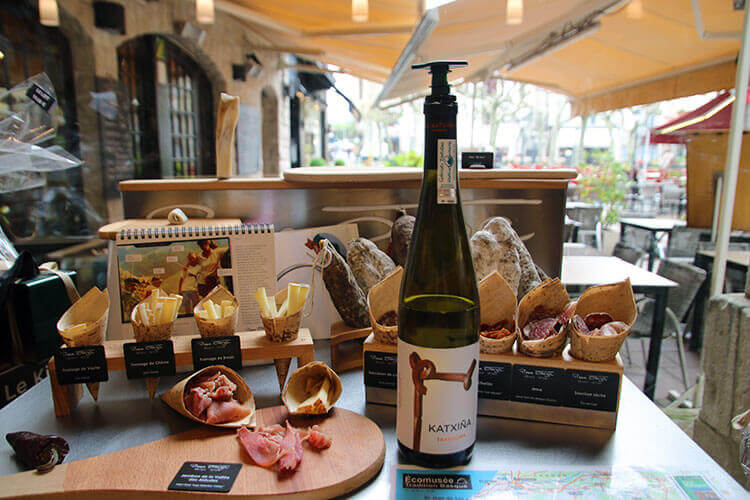
Jambon Kintoa: Pierre Oteiza
You probably know Jamón Ibérico and Proscuitto di Parma. You might even know Proscuitto di San Daniele. But the French also have a famous ham, and unsurprisingly, it comes from French Basque Country.
Jambon Kintoa is made from a rare breed of Basque pig called the Pie Noir du Pays Basque. The breed nearly went extinct in the 1980s, with only around 100 pigs remaining. Conversation efforts were put in place at that time to preserve the breed, and now today there are around 70 farms raising the Pie Noir du Pays Basque in the traditional rearing processes.
This ham gets its name from the period of the Kingdom of Navarre from 824 – 1512. There were three common breeds of pigs that lived in the Pyrénées at that time, though only the Pie Noir du Pays Basque remains today. In exchange for the farmers being allowed to graze their pigs on the slopes of the Pyrénées, the King of Navarre demanded each farmer give him one fifth of their herd of pigs. This tax was known as “kintoa,” meaning a fifth in the Basque language. And so that area highly suited to farming pigs eventually became known as Kintoa.
Considered a grand cru of hams just as Bordeaux is one of the top in the wine world, the Basque pigs roam free within their farms eating whatever they want like acorns, chestnuts beechnuts and natural cereals. Jambon Kintoa is an AOC product (appellation d’origine contrôlée), meaning there are strict regulations surrounding the entire process from where and how the pigs are raised to how the ham is cured.
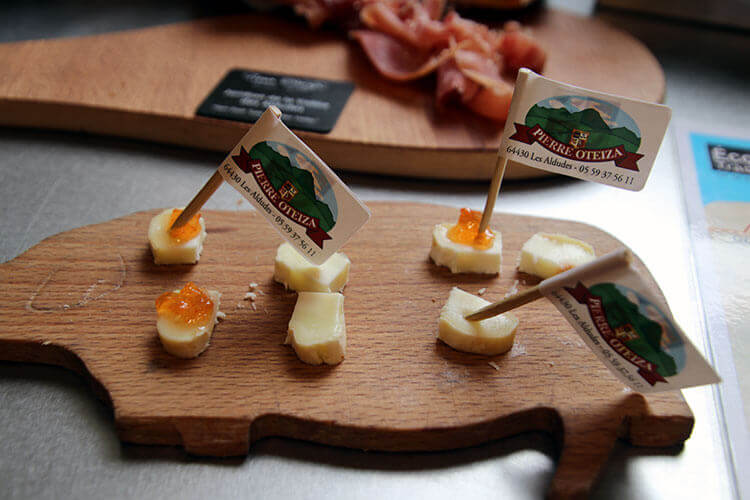
Pierre Oteiza is one of the most well-known producers, and a champion charcutier breeding his pigs since 1987. He’s built an empire with shops all over French Basque Country, one in Bordeaux and two in Paris. You can arrange a visit to the farm in Les Aldudes, about 50 kilometers from Bayonne, but you definitely won’t want to miss tasting the Jambon Kintoa at the shop in Saint-Jean-de-Luz.
Pierre Oteiza’s Jambon Kintoa is salt cured with salt that comes from the Bassin de l’Adour for a minimum of 17 months in their natural drying sheds. The meat is marbled since this breed of pig tends to be fattier, and the ham has a nutty taste from the pigs’ diet. It quite literally melts in your mouth and is like nothing you’ve ever tasted before. Luckily, you can purchase some Jambon Kintoa vacuum sealed to take home with you.
Pierre Oteiza, 10 Rue de la République
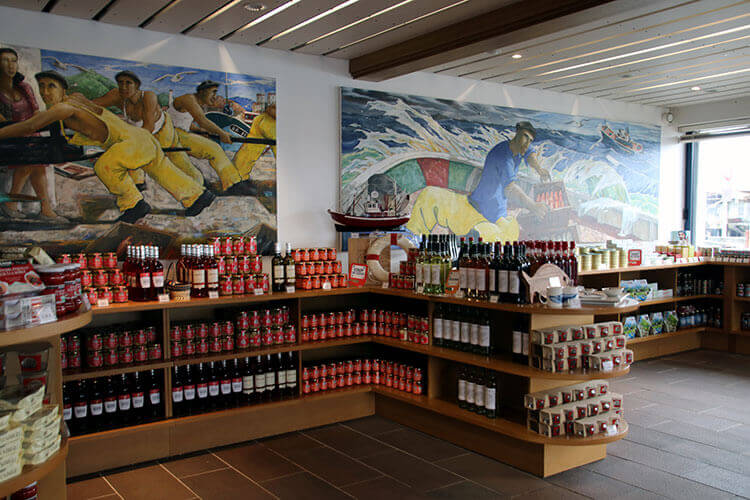
Sardines, Anchovies and Tuna: Le Comptoir de la Mer
Saint-Jean-de-Luz is a fishing port and fishing is still very much the industry here today. That’s evident as you wander the port and watch as the fishing boats sail in and out of the harbor, a pile of nets that need repairing strung along the walkways.
One of the world’s greatest delicacies comes from these waters: the Bay of Biscay anchovy. A Basque specialty, it too was nearly wiped out like the black Basque pigs. Strict regulations had to be put in place just over a decade ago due to overfishing and new fisherman using drag net methods that harm the fragile underwater ecosystem of the Bay of Biscay.
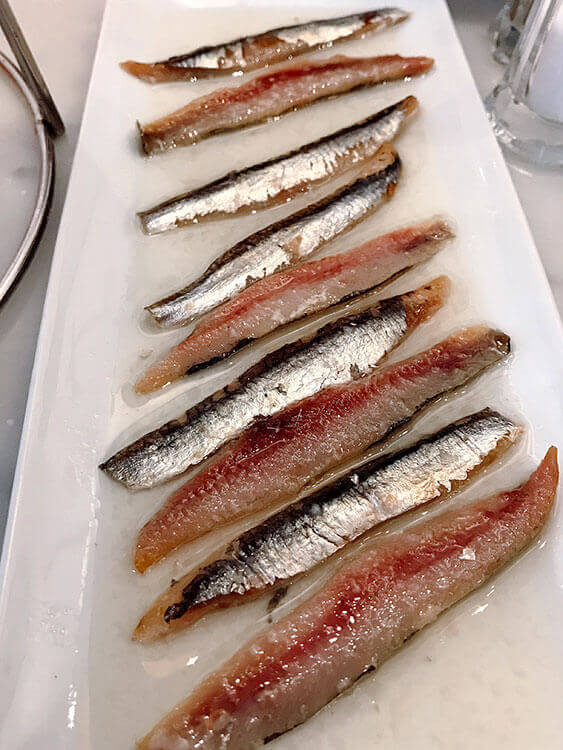
I’m particularly picky when it comes to fish, and I’ve had precisely two anchovies ever that I’ve liked: pickled anchovies once in Barcelona on a Devour Spain food tour and these smoked anchovies that were described as “very special.” Very special, indeed. Anchovies that come from the cool waters of the Bay of Biscay have an extra layer of fat, which makes them incredibly tender. Since anchovies are a migratory fish, they’re caught from late winter to early summer during the spawning season. Typically, the fisherman’s wives would keep them in salt until they were ready to eat them. You can also find them smoked and then put in olive oil. I really don’t like anchovies, and yet I devoured the entire plate.
Sardines are also important here and the tins of them come in all sorts of varieties like citrus, Espelette pepper or garlic. I did try them, I’m fairly certain for the first time ever, and sardines are just a bit too fishy for my liking.
The tuna here won’t remotely resemble the StarKist can you buy at home. Albacore “white” tuna are line caught in the Bay of Biscay and the tuna is so flaky and delicious that you’ll be ruined from your favorite grocery store brand of canned tuna for life.
Le Comptoir de la Mer, Quai François Turnaco
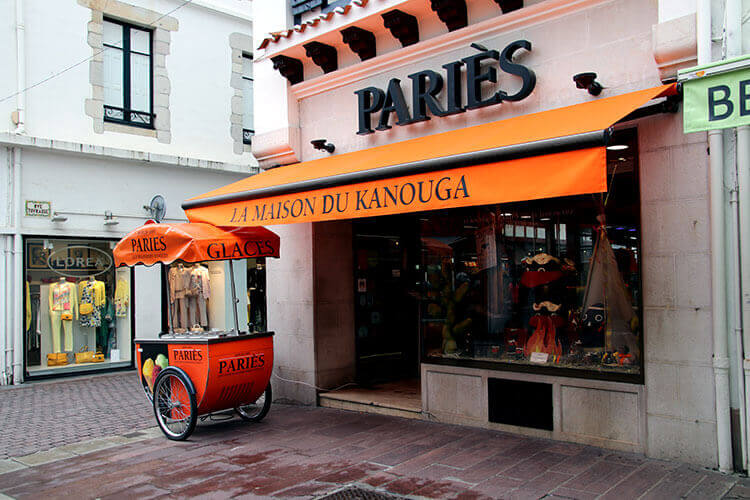
Kanouga, Mouchou and Gâteau Basque: Pariès
Pariès has been producing gourmet Basque specialties since 1895, though they actually started just up the coast in Bayonne as a master chocolate maker. But it was two key products invented by different generations of the family that would put Pariès on the map.
Founder and master chocolate maker Jacques Damestoy invented a type of caramel and fondant in 1905 that he called Le Kanouga. At that time in Biarritz, many Russian aristocrats visited often and Jacques was amused by it all. He decided one day to pull out of map of Russia, point randomly to a place on the map and that this is what his new candy would be called. His finger landed on Kaluga and so his new candy was ever-so-slightly altered to be named Le Kanouga. It’s still made today in six flavors: chocolate, coffee, vanilla-almond, coffee-hazelnut, chocolate-walnut and salted caramel butter with Espelette pepper.
Jacques handed over his shop to his daughter in 1914, which had by then already moved to Saint-Jean-de-Luz. Catherine’s married name was Pariès and it was her married name that gave the name to the shop.
Pariès second key product that gave them recognition came from Robert Pariès, Jacques grandson. Robert invented Mouchou in 1948. From the Basque word muxu, meaning a kiss, it’s often confused as another type of macaron. There is much more almond in Mouchou than in a macaron, giving it a unique soft center inside the slightly crunchy exterior. It also looks like it’s two cookies sandwiched together, but a Mouchou is one piece. These also come in several flavors: almond, pistachio, chocolate, hazelnut and coffee. They’ll keep for about 8 days.
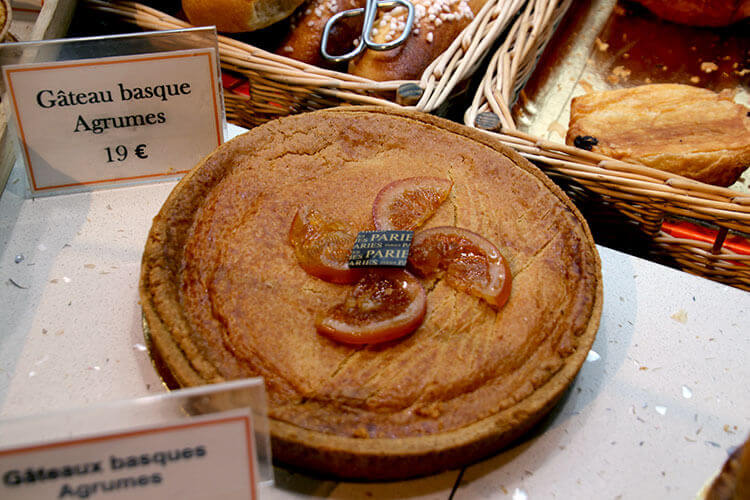
Pariès are known as one of best pâtisserie on the Basque Coast and their said to make one of the best gâteau basque around. A traditional Basque dessert, it’s thought that gâteau basque started in the 18th century and was first a type of bread. It’s made from almonds traditionally, and in the summer months might be filled with the Basque black cherries. Every family has their own unique recipe and Pariès has been handed down through their family.
You can purchase all of Pariès chocolates, pastries and specialties at their flagship shop in Saint-Jean-de-Luz, or if you have time you can also visit the workshop on the other side of the bay for a guided tour. In the workshop, you get a look at how Pariès products are made and at the end of the tour there’s a tasting.
Pariès, 9 Rue Léon Gambetta. Guided tours are available by appointment only by calling 33 559 22 06 00. Guided tours are 30 minutes and are €5 for adults and €3 for children.
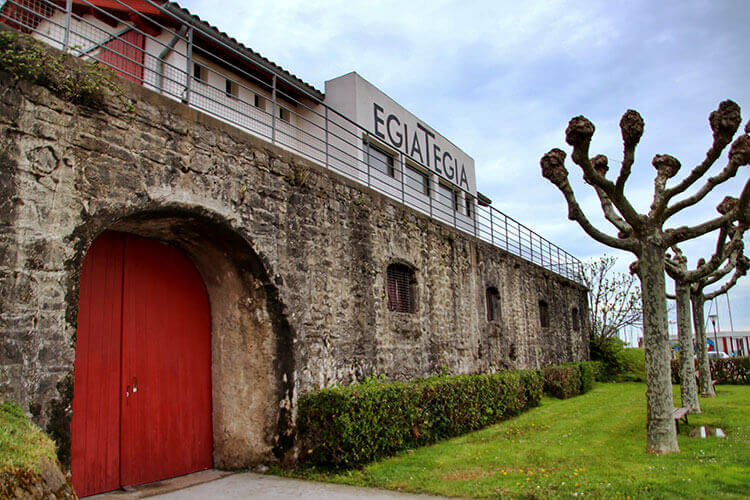
Ocean-Aged Wine: Egiategia
Just two hours south of Bordeaux, it’s Bordeaux and Spanish wines that dominate the wine lists in the Pays Basque. Not really a wine making region, winemaker Emmanuel Poirmeur is challenging that with his unique winery Egiategia.
Emmanuel was born in Paris, summered with his family in Saint-Jean-de-Luz and worked in one of the top Champagne houses. It was there in Champagne that he got the idea for a winery quite literally like no other in the world. And as Emmanuel has patented his aging method, Egiategia will remain one-of-a-kind.
While working in Champagne, Emmanuel theorized that aging wine under the sea would provide a stable environment with consistent temperatures. So he filled a tank with wine and sunk it inside of 4-ton concrete egg that he had anchored to the seabed 15 meters down behind the break wall that protects Saint-Jean-de-Luz’s bay. The wine would age in the concrete egg for nine months before being pulled out to see the results. The concrete egg still sits outside Egiategia and a video plays showing the boat, crane and scuba divers necessary for this process.
The ocean had rocked the wine into a very lightly sparkling wine and Emmanuel felt the results were spectacular. What wasn’t sustainable was the amount of equipment and divers needed. And so, Egiategia began a series of tests over the last decade and the process of aging wine in the ocean has evolved. At one point, some of the buoy-like tanks even went missing for a while. Eventually they washed up and thanks to Egiategia branded on the buoys, they were returned.
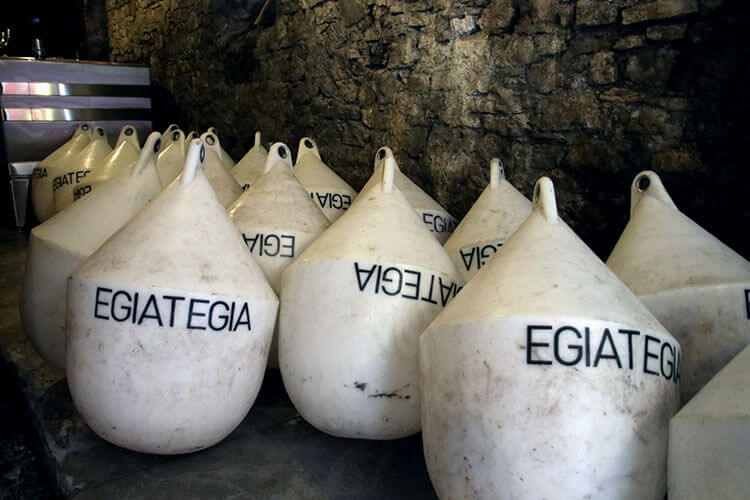
Emmanuel’s now using water tight 300-liter tanks that look a bit like buoys. The process is down to a fine art form with just two divers necessary. Egiategia’s unfiltered and 100% ocean-aged wines are bottled straight out of their tanks when they’re pulled from the sea floor.
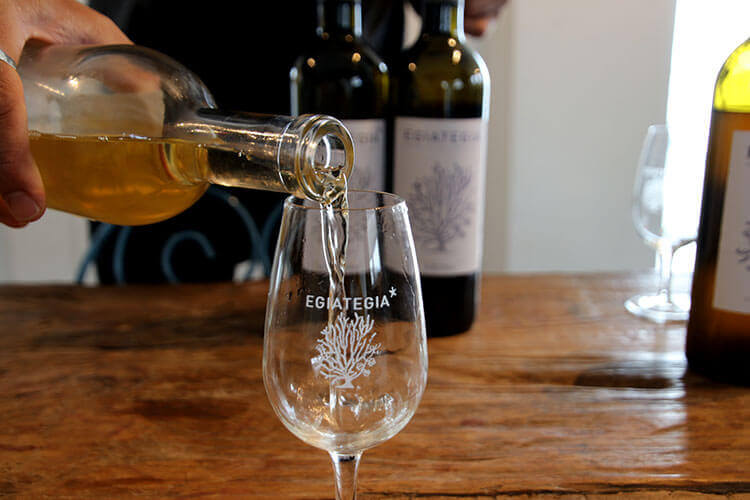
Egiategia produces white, red and rosé. The filtered version of each comes out of the ocean and is placed in tanks in the cellar beneath the tasting room and boutique, before being bottled. But it’s the unfiltered versions of these wines that really shine with their sparkling characteristics from ocean-aging. The bubbles from the gases created are a fun addition, but if the gases are too much you simply swirl your glass and wait a few minutes for them to mostly evaporate out. The red reminds us a bit of a Lambrusco with the sparkling characteristics. The unfiltered Dena Dela Rosé is our favorite, and I can totally imagine drinking it on a hot summer day.
You can book a visit to taste the wines and tour the cellar, which is in a historic house on the Socoa Beach. This house was actually the place where the break wall was constructed under Napoleon. He had ordered the wall built after this boat nearly sank with his wife onboard in the Atlantic swells. In the summertime, there’s also opportunity to book either a boat cruise or a stand-up paddle board and go out to the seawall to see the tanks anchored below. After, you return to the tasting room for a taste of the wines. Even with the wall bearing the brunt of the Atlantic’s waves, you’ll definitely be working for your wine.
Egiategia, Zone Portuaire de Socoa. Email [email protected] to reserve your visit in advance.
Know Before You Go
Our trip to Pays Basque was in partnership with Pays Basque Tourisme, Terre & Cote Basques and Région Nouvelle Aquitaine in order to bring you this story. However, Bordeaux Travel Guide maintains full editorial control of the content published on this site. As always, all thoughts, opinions, and enthusiasm for travel are entirely our own. This article contains affiliate links. When you book on Booking.com or SNCF through our affiliate sites, we earn a small commission at no additional cost to you.
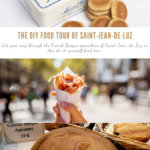
Leave a Reply